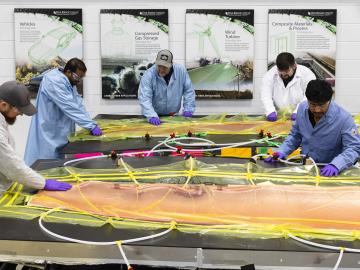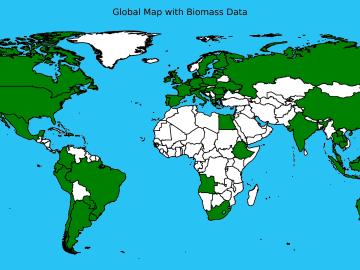
Filter News
Area of Research
- Advanced Manufacturing (1)
- Biological Systems (1)
- Biology and Environment (94)
- Biology and Soft Matter (1)
- Clean Energy (65)
- Climate and Environmental Systems (2)
- Computer Science (1)
- Fusion and Fission (9)
- Fusion Energy (1)
- Isotopes (1)
- Materials (50)
- Materials for Computing (2)
- National Security (25)
- Neutron Science (19)
- Nuclear Science and Technology (9)
- Quantum information Science (2)
- Supercomputing (38)
News Type
News Topics
- (-) Advanced Reactors (19)
- (-) Bioenergy (75)
- (-) Clean Water (17)
- (-) Cybersecurity (31)
- (-) Environment (143)
- (-) Physics (56)
- 3-D Printing/Advanced Manufacturing (91)
- Artificial Intelligence (89)
- Big Data (39)
- Biology (84)
- Biomedical (50)
- Biotechnology (21)
- Buildings (38)
- Chemical Sciences (60)
- Climate Change (76)
- Composites (20)
- Computer Science (152)
- Coronavirus (34)
- Critical Materials (16)
- Decarbonization (68)
- Education (5)
- Element Discovery (1)
- Emergency (2)
- Energy Storage (73)
- Exascale Computing (44)
- Fossil Energy (5)
- Frontier (44)
- Fusion (47)
- Grid (42)
- High-Performance Computing (82)
- Hydropower (5)
- Isotopes (49)
- ITER (4)
- Machine Learning (39)
- Materials (106)
- Materials Science (103)
- Mathematics (7)
- Mercury (9)
- Microelectronics (4)
- Microscopy (36)
- Molten Salt (4)
- Nanotechnology (42)
- National Security (66)
- Net Zero (11)
- Neutron Science (107)
- Nuclear Energy (83)
- Partnerships (52)
- Polymers (20)
- Quantum Computing (34)
- Quantum Science (62)
- Renewable Energy (2)
- Security (24)
- Simulation (44)
- Software (1)
- Space Exploration (15)
- Statistics (3)
- Summit (55)
- Sustainable Energy (79)
- Transformational Challenge Reactor (7)
- Transportation (52)
Media Contacts

Researchers led by the University of Melbourne, Australia, have been nominated for the Association for Computing Machinery’s 2024 Gordon Bell Prize in supercomputing for conducting a quantum molecular dynamics simulation 1,000 times greater in size and speed than any previous simulation of its kind.

ORNL researchers were honored with a prestigious ACE Award for Composites Excellence by the American Composites Manufacturers Association. The team won the “innovation in green composites design” prize for creating a fully recyclable, lightweight wind turbine blade tip that incorporates low-cost carbon fiber and conductive coating for enhanced protection against lightning strikes.

A new Global Biomass Resource Assessment developed by ORNL scientists gathered data from 55 countries resulting in a first-of-its kind compilation of current and future sustainable biomass supply estimates around the world.

A study led by the Department of Energy’s Oak Ridge National Laboratory details how artificial intelligence researchers created an AI model to help identify new alloys used as shielding for housing fusion applications components in a nuclear reactor. The findings mark a major step towards improving nuclear fusion facilities.

A team led by scientists at ORNL identified and demonstrated a method to process a plant-based material called nanocellulose that reduced energy needs by a whopping 21%, using simulations on the lab’s supercomputers and follow-on analysis.

Nuclear physicists at the Department of Energy’s Oak Ridge National Laboratory recently used Frontier, the world’s most powerful supercomputer, to calculate the magnetic properties of calcium-48’s atomic nucleus.

Debjani Singh, a senior scientist at ORNL, leads the HydroSource project, which enhances hydropower research by making water data more accessible and useful. With a background in water resources, data science, and earth science, Singh applies innovative tools like AI to advance research. Her career, shaped by her early exposure to science in India, focuses on bridging research with practical applications.

A study found that beaches with manmade fortifications recover more slowly from hurricanes than natural beaches, losing more sand and vegetation. The researchers used satellite images and light detection and ranging data, or LIDAR, to measure elevation changes and vegetation coverage. Changes in elevation showed how much sand was depleted during the storm and how much sand returned throughout the following year.

Scientists have determined that a rare element found in some of the oldest solids in the solar system, such as meteorites, and previously thought to have been forged in supernova explosions, actually predate such cosmic events, challenging long-held theories about its origin.

To better predict long-term flooding risk, scientists at the Department of Energy’s Oak Ridge National Laboratory developed a 3D modeling framework that captures the complex dynamics of water as it flows across the landscape. The framework seeks to provide valuable insights into which communities are most vulnerable as the climate changes, and was developed for a project that’s assessing climate risk and mitigation pathways for an urban area along the Southeast Texas coast.


